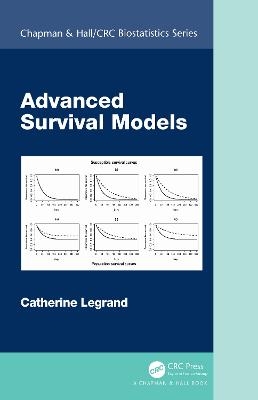
Advanced Survival Models
Chapman & Hall/CRC (Verlag)
978-0-367-14967-3 (ISBN)
Survival data analysis is a very broad field of statistics, encompassing a large variety of methods used in a wide range of applications, and in particular in medical research. During the last twenty years, several extensions of "classical" survival models have been developed to address particular situations often encountered in practice. This book aims to gather in a single reference the most commonly used extensions, such as frailty models (in case of unobserved heterogeneity or clustered data), cure models (when a fraction of the population will not experience the event of interest), competing risk models (in case of different types of event), and joint survival models for a time-to-event endpoint and a longitudinal outcome.
Features
Presents state-of-the art approaches for different advanced survival models including frailty models, cure models, competing risk models and joint models for a longitudinal and a survival outcome
Uses consistent notation throughout the book for the different techniques presented
Explains in which situation each of these models should be used, and how they are linked to specific research questions
Focuses on the understanding of the models, their implementation, and their interpretation, with an appropriate level of methodological development for masters students and applied statisticians
Provides references to existing R packages and SAS procedure or macros, and illustrates the use of the main ones on real datasets
This book is primarily aimed at applied statisticians and graduate students of statistics and biostatistics. It can also serve as an introductory reference for methodological researchers interested in the main extensions of classical survival analysis.
Catherine Legrand is Professor in Statistics and Biostatistics at the Institute of Statistics, Biostatistics, and Actuarial Sciences (ISBA-LIDAM) of the Université Catholique de Louvain (UCLouvain, Belgium). She obtained a Master Degree in Mathematics from the Université Libre de Bruxelles (ULB, Belgium) in 1998. She worked for 7 years at the European Organization for Research and Treatment of Cancer (EORTC, Brussels) and became the primary statistician of the EORTC Lung Cancer Group. She was also a member of the EORTC Treatment Outcome Research Group, the Elderly Task Force, and coordinator of the EORTC Independent Data Monitoring Committee. In parallel, she completed a PhD in 2005 at the Center for Statistics, Hasselt University, in the field of survival analysis (frailty models). Early 2006, she started working as biometrician at Merck Sharp & Dohme (MSD) where she was involved in the design and analysis of clinical trials in respiratory diseases. In September 2007, she joined the Université Catholique de Louvain (UCLouvain). Her area of research includes survival data analysis, design and analysis of clinical trials and analysis of medical data. Along with these professional experiences, she co-authored more than 80 papers in peer-reviewed clinical and statistical journals.
1. Introduction
2. Classical Survival Analysis
3. Frailty Models
4. Cure Models
5. Competing Risks
6. Joint Modeling
| Erscheinungsdatum | 25.03.2021 |
|---|---|
| Reihe/Serie | Chapman & Hall/CRC Biostatistics Series |
| Zusatzinfo | 34 Tables, black and white; 45 Illustrations, black and white |
| Sprache | englisch |
| Maße | 156 x 234 mm |
| Gewicht | 453 g |
| Themenwelt | Mathematik / Informatik ► Mathematik |
| Studium ► Querschnittsbereiche ► Epidemiologie / Med. Biometrie | |
| ISBN-10 | 0-367-14967-2 / 0367149672 |
| ISBN-13 | 978-0-367-14967-3 / 9780367149673 |
| Zustand | Neuware |
| Haben Sie eine Frage zum Produkt? |
aus dem Bereich


